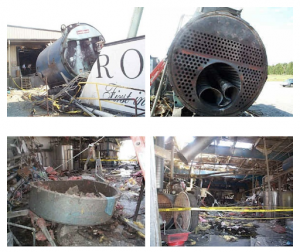The National Board of Boiler and Pressure Vessel Inspectors have reported on boiler incidents over the last few decades. While boiler incident statistics and awareness have improved, low-water cutoff issues are still the most common cause of boiler failure. As a boiler operator, it’s important to understand local boiler codes & standards, boiler manufacturer maintenance recommendations, follow operator guidelines and proper maintenance to avoid issues.
A low-water cutoff device is installed on all steam or hot water boilers to monitor the boiler water level. The device has a mechanical or electronic sensor and will shut down the boiler before the point the equipment becomes unsafe.
How it happens
When water is heated and converted into steam, it expands at a rate of 1600 times its volume at atmospheric pressure, when compared to what it was as a liquid. This huge expansion, when released, causes the enormous forces evidenced in the pictures shown below.
Failures are often the result of an improperly maintained or faulty level control which fails to shut the burner off at the proper low water point. When the water level drops below the top of the furnace the metal overheats and loses tensile strength, resulting many times in a rupture of the furnace and tube sheet causing a steam explosion, rocketing the boiler great distances across the room.

Tips to prevent low-water cutoff failure
- Maintain a boiler log and record regular maintenance procedures
- Adhere to a regular maintenance schedule
- Monitor your boiler for unusual noises or physical signs like cracks and leaks
- Blowdown your boiler according to the manufacturers’ recommendations to prevent sediment buildup
